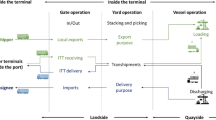Abstract
In this paper, we study the crane scheduling problem for a vessel after the vessel is moored on a terminal and develop both exact and heuristic solution approaches for the problem. For small-sized instances, we develop a time-space network flow formulation with non-crossing constraints for the problem and apply an exact solution approach to obtain an optimal solution. For medium-sized instances, we develop a Lagrangian relaxation approach that allows us to obtain tight lower bounds and near-optimal solutions. For large-sized instances, we develop two heuristics and show that the error bounds of our heuristics are no more than 100%. Finally, we perform computational studies to show the effectiveness of our proposed solution approaches.
Similar content being viewed by others

References
Cordeau, J. F., Laporte, G., Legato, P., & Moccia, L. (2005). Models and tabu search heuristics for the berth-allocation problem. Transportation Science, 39, 526–538.
Daganzo, C. F. (1989). The crane scheduling problem. Transportation Research B, 23(3), 159–175.
Hansen, P., Oguz, C., & Mladenovic, N. (2008). Variable neighborhood search for minimum cost berth allocation. European Journal of Operational Research, 191, 636–649.
Imai, A., Sun, X., Nishimura, E., & Papadimitriou, S. (2005). Berth allocation in a container port: using a continuous location space approach. Transportation Research B, 39, 199–221.
Kalvelagen, E. (2002). Lagrangian relaxation with GAMS. Tech. rep., GAMS Development Corp.
Kim, K. H., & Park, Y. M. (2004). A crane scheduling method for port containers. European Journal of Operational Research, 156, 752–768.
Lee, D. H., Wang, H. Q., & Miao, L. (2008). Quay crane scheduling with non-interference constraints in port container terminals. Transportation Research E, 44, 124–135.
Lim, A., Rodrigues, B., Xiao, F., & Zhu, Y. (2002). Crane scheduling using tabu search. In Proceedings of the 14th IEEE international conference on tools with artificial intelligence.
Lim, A., Rodrigues, B., & Xu, Z. (2007). A m-parallel crane scheduling problem with a non-crossing constraint. Naval Research Logistics, 54, 115–127.
Liu, J., Wan, Y., & Wang, L. (2005). Quay crane scheduling at container terminals to minimize the maximum relative tardiness of vessel departures. Naval Research Logistics, 53, 60–74.
Moccia, L., Cordeau, J., Gaudioso, M., & Laporte, G. (2006). A branch-and-cut algorithm for the quay crane scheduling problem in a container terminal. Naval Research Logistics, 53, 45–59.
Monaco, M. F., & Sammarra, M. (2007). The berth allocation problem: A strong formulation solved by a lagrangean approach. Transportation Science, 41(2), 265–280.
Peterkofsky, R. I., & Daganzo, C. F. (1990). A branch and bound solution method for the crane scheduling problem. Transportation Research B, 24(3), 159–172.
Stahlbock, R., & Voß, S. (2008). Operations research at container terminals: a literature update. OR Spectrum, 30, 1–52.
UN (2005). Regional shipping and port development strategies (Container Traffic Forecast). United Nations.
Wang, F., & Lim, A. (2007). A stochastic beam search for the berth allocation problem. Decision Support Systems, 42, 2186–2196.
Zhu, Y., & Lim, A. (2006). Crane scheduling with non-crossing constraint. Journal of the Operational Research Society, 57(12), 1464–1471.
Author information
Authors and Affiliations
Corresponding author
Rights and permissions
About this article
Cite this article
Guan, Y., Yang, KH. & Zhou, Z. The crane scheduling problem: models and solution approaches. Ann Oper Res 203, 119–139 (2013). https://doi.org/10.1007/s10479-010-0765-3
Published:
Issue Date:
DOI: https://doi.org/10.1007/s10479-010-0765-3



